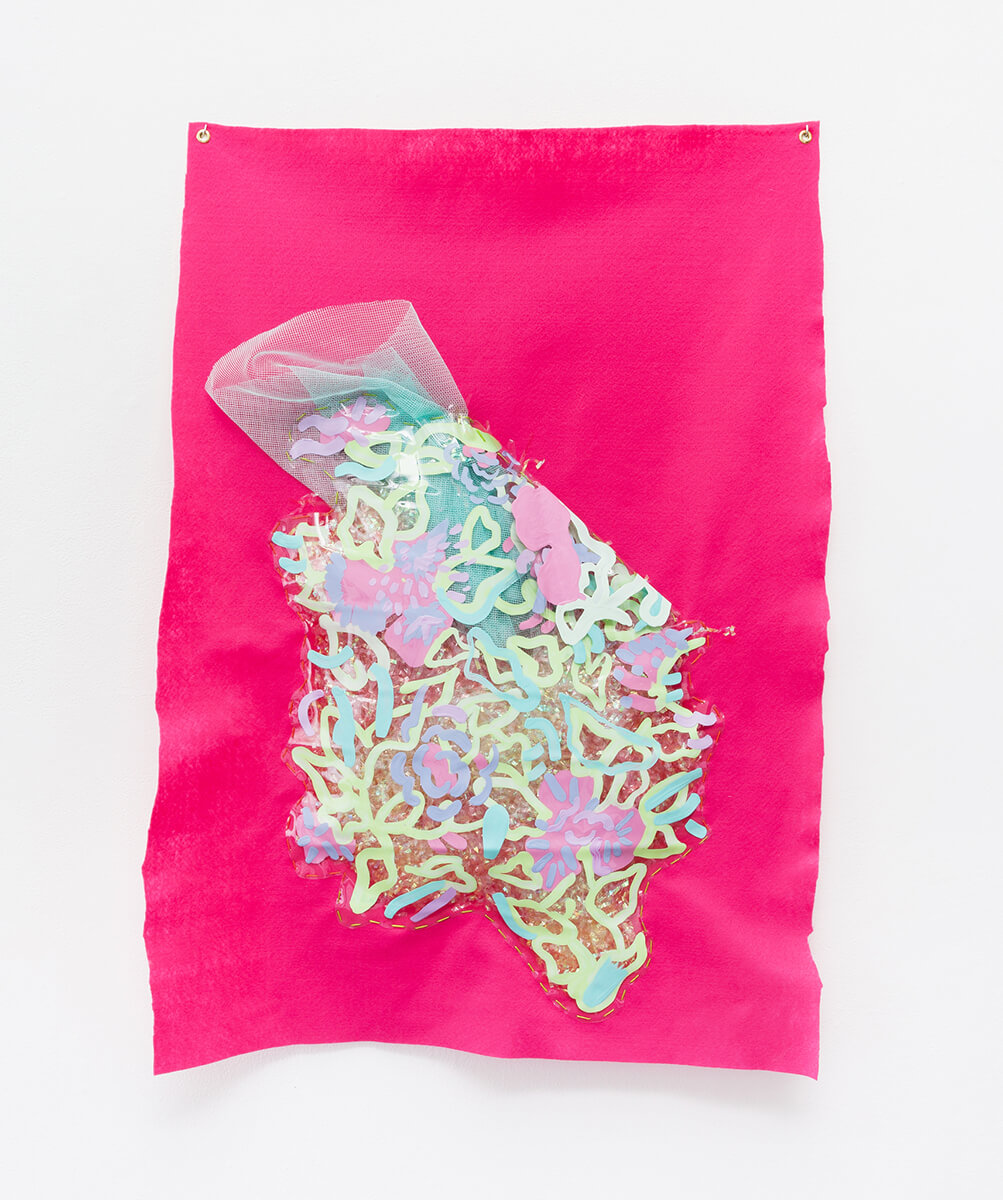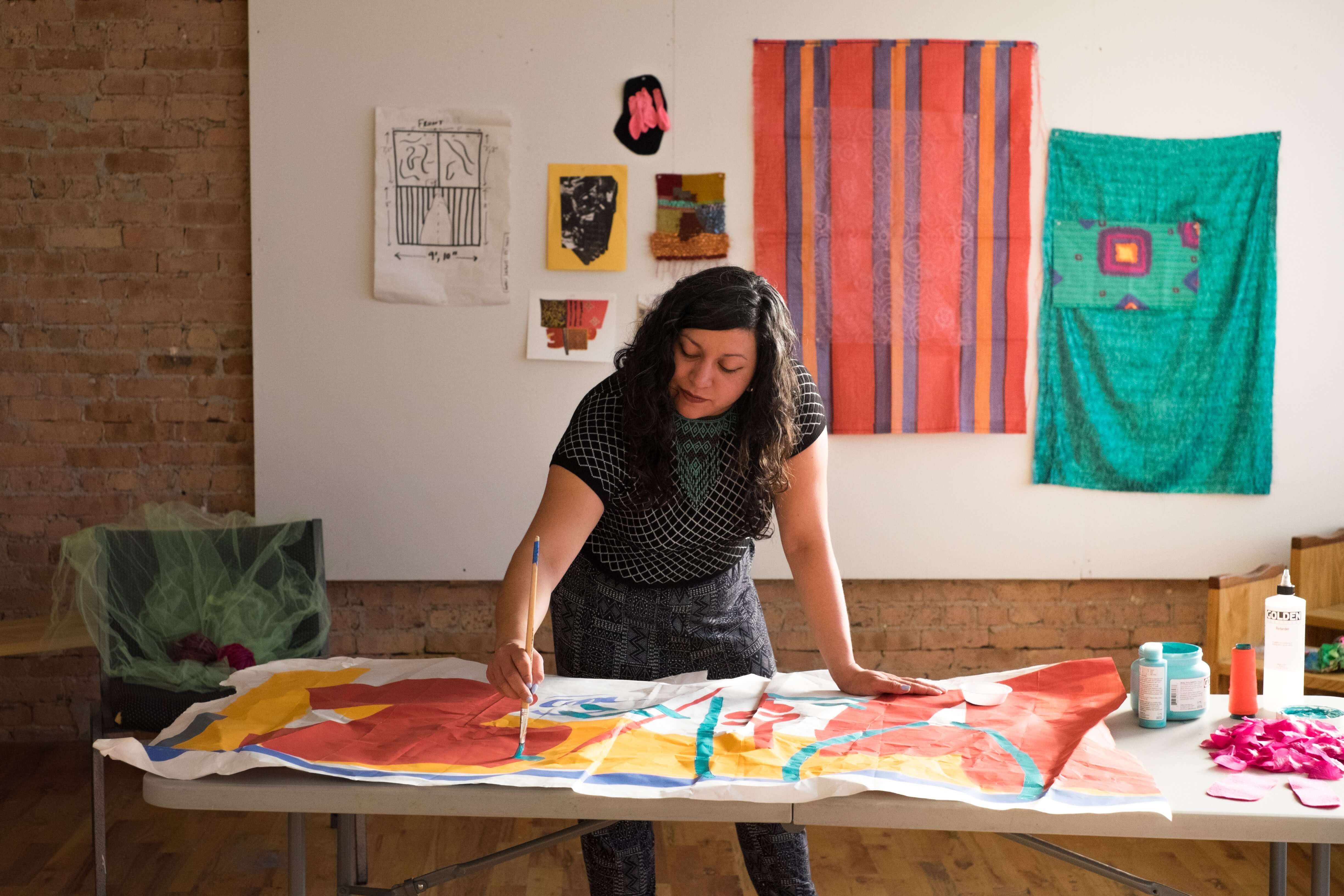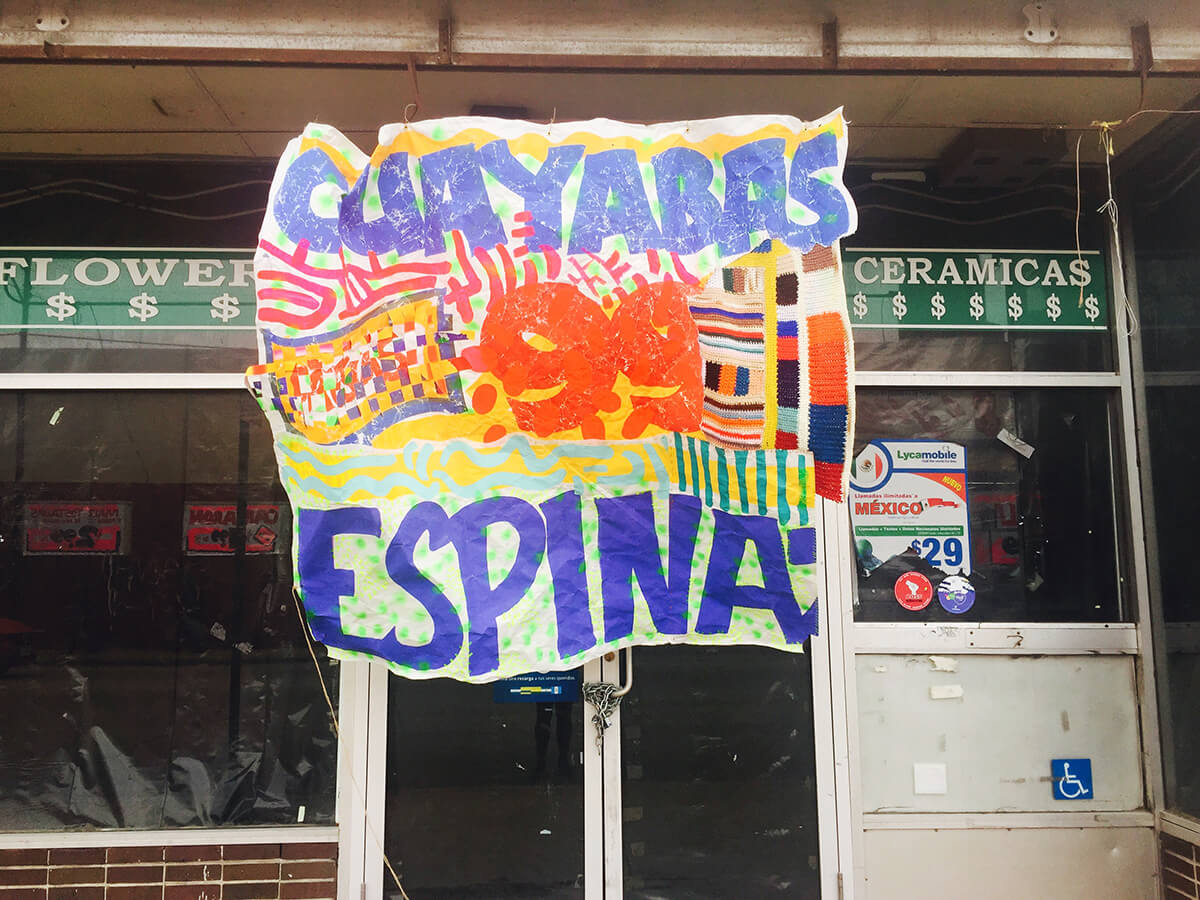Tell us a little bit about yourself and what you do. I’m an artist who believes in the make-do and can adapt to various environments. I love the color lime green, sharing ice cream with friends, smelling flowers on a daily basis, and traveling whenever I can. Part of my practice involves working with youth because I believe I have a responsibility as an artist to share my skills with the younger generation. I believe that fabric is a universal material and relate it to skin. One of my goals is to work with this material throughout the different stages in my career and abroad.

What are some recent, upcoming or current projects you are working on? I currently made a fourteen-foot tall project that I like to think of as a “soft portal.” It’s a double-sided fiber painting with hand-sewn details including felt, lace, and fragments of hand painted signs from Mexican grocery stores from Pilsen, which is where I grew up. I added light padding in between the paintings to add a layer of dimension and cut a doorway in the middle of the piece so the audience could walk through the project and experience the other side breathing. This piece is currently on view until February 25, 2018 at Pelican Bomb Gallery in New Orleans, which is in conjunction with Prospect. 4. I’ve also been selected as one of the artists-in-residence at the University of Chicago and my studio is located at the Arts Incubator. My goals are to study Mexican and African textiles to learn about the similarities between materiality, color, symbolism, patterns, and history that exist between both cultures. This research will be shared with youth from Washington Park, Bronzeville, and Gage Park, and together we will create a collaborative project near the Arts Incubator and Arts Block.
How did your interest in art begin? It began in Pilsen. There are significant layers that made me realize as a child that I would become an artist. Some of these memories include experiencing graffiti artists climbing on the train tracks on the Blue Line before it was the Pink Line. I remember waiting for the bus with my mom and watching this young person in broad daylight climbing higher and higher, which I thought was impressive since nothing stopped the individual to make a mark on public space. I would also like to share that one time I was walking back home from the grocery store with my mom and noticed a mural of a girl with brown hair, brown eyes, and brown skin wearing a hunter green shirt. My intuition inspired me to run towards the painting and down the gangway of the building, which led to a party of males engaging in day drinking, or a “daytime.” My mom got so upset with me for running into this party but I thought it was fun because I felt like I was breaking some kind of rule. Also, I always shown a great interest in the arts as a child and my CPS teachers always encouraged my parents to enroll me in youth courses at the Art Institute of Chicago. There was a point in fourth grade when my teachers wanted to send me on a European art experience that was out of my parent’s budget so I didn’t go nor did I take the youth courses since both of my parents were always working in factories. Instead my mom would take me to the neighborhood thrift stores in Pilsen and I started to play this game where I collected brightly patterned toys and incomplete puzzles. Once we took the items home she would clean them and I would begin to create collages on a small table dedicated to my art. This really made my childhood special especially since Pilsen was an entirely different Pilsen than it is today.

If you had to explain your work to a stranger, what would you say? I would say that my work is like skin composed of layers of mysterious yet enchanting materials inherited and inspired by Mother Earth’s cousin, the urban environment, thrift stores, friends, local establishments, and found images that I carefully collage and stitch together. I would say that the poems and memories I visually compose are usually tall and full of wonder channeling a combination of past and present energies ready to exist, disappear, and reincarnate into another form of life.
What was the last exhibition you saw that stuck out to you? It was Julien Creuzet’s solo exhibition at DOCUMENT. I fell in love with the poetry that was engraved onto his photomontages and clear acrylic sheets. There was something very special about these pieces. The writing was subtle on the material so I had to carefully follow each letter on the organic imagery. I also remember there being videography and psychedelic audio that was beautifully hypnotizing. Creuzet’s work placed me in another environment and I appreciate how he transposed the gallery into another type of world. His art granted me a sense of peace and I look forward to experiencing more.

What do you collect? I collect crystals, flowers, and fabric when I travel. I collect items such as cassette tapes, fruit nets, and parade streamers that I find on the ground when I’m in deep thought. I also collect paint chips from underneath bridges as I slide my hands on the walls. This reminds me of the murals that were erased at Casa Aztlan in Pilsen recently. Casa Aztlan was a community space where free art classes were offered, artists had studios, punk shows existed, and Mexican immigrants found support by learning about their human rights. It was a space covered in art and where I met one of my mentors, the professor Nicole Marroquin who teaches at SAIC. When I was in high school I helped a friend paint a mural on the playground, and once I found out the murals were being erased I biked to the site to collect a small piece of the mural before it was completely removed. All of these memories are dear to me and part of me believes that decaying paint holds a special type of energy. Ray Patlan, Hector Duarte, and other local artists are now painting the building, and I’m curious what will happen next to the space.

What’s your favorite thing about Chicago? My favorite thing about Chicago is the Textile Discount Outlet! I can spend my entire day here exploring and falling deeper in love with fabric. I wish I could live here and I think that if the world were to end, I would go there and hide underneath piles and piles of fiber in hopes of surviving. It’s full of color and all the staff is very friendly. They always ask me what I’m working on and help me out with measurements.
What do you do when you’re not working on your art? When I’m not in my studio I am rock climbing, swimming, prepping for classes, or laughing with my friends. I enjoy rock climbing because it reminds me of my time spent in South America when I was going on daily hikes on ruins and it motivates me to create large-scale projects. One day I hope I can return to South America and work with a group of people to respond to an outdoor site incorporating fiber and natural pigments. When I swim I like to relax my mind and remind myself not to be so hard on myself. After swimming forty to fifty laps, I float and think of what a water lily feels like existing in a body of water. I also appreciate spending time with my friends because we share meals together, reflect, hear each other, and light up sage to cleanse and relax.
Describe your current studio or workspace. My current studio is at the Arts Incubator and I absolutely love it. Before that I was working out of my apartment in Pilsen and didn’t have enough room so I’m very happy that I now have a lot of space to expand my vision. There are wooden floors, tall ceilings, table space, wall space, and huge windows so I am grateful for the natural lightning when I’m working and documenting my artwork. I also have access to a garden and the woodshop so I’m excited how part of my practice will transform.

Can you share one of the best or worst reactions you have gotten as a result of your work? One of the best reactions I have gotten as a result of my work was after presenting at the Wall of Respect Symposium at the Block Museum of Art last spring. I met Adeola Enigbokan, an artist and urbanist based in Amsterdam who also presented in the symposium. She commented that my work is like “spells.” I thought this was quite intriguing since I never heard someone translate my mark making as such an action or influence. I mainly presented about my outdoor art that is accessible to the public, so there is more research for me to decipher based on her words.

Additional, upcoming projects include a group show at Latino Arts Inc. curated by Edra Soto and a solo exhibition at Loyola University Museum of Art.
